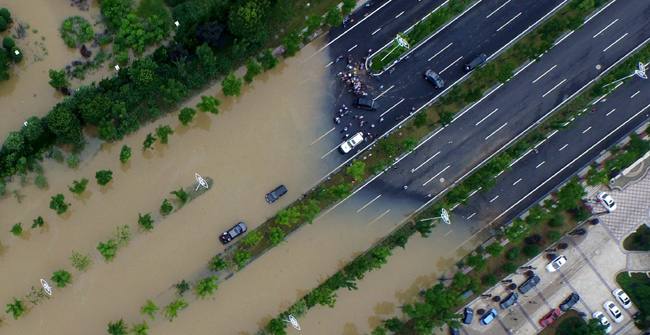Qinghai cleanup begins to take flight
Updated: 2015-07-21 07:51
By Kang Bing and Liu Xiangrui(China Daily)
|
|||||||||||
Efforts to restore and protect the environment around China's largest inland lake are ensuring the safety of migratory bird species and local wildlife, and turning back the eco-clock to the 1980s heyday. Kang Bing and Liu Xiangrui report from Xining.
Almost every day, Li Yinghua walks through a window-lined sunken passage to his office, where banks of computer screens show real-time images of wild birds in the Qinghai Lake National Nature Reserve in Qinghai province.
"It's my job to monitor the screens," he said. "I observe the birds' activities, captured by video cameras installed at different points, to keep a record and watch for signs of abnormality."
The protection and study of migratory birds is one of the reserve's most important functions, and Li's office is on "Bird Island", which is actually a 1,500-meter-long peninsula on the lake's northwestern shore. The island's flat terrain and elevated location - the lake is more than 3,200 meters above sea level - make it an ideal nesting site for dozens of species of migratory birds, including a number of rarities. During peak breeding season, it's home to tens of thousands of birds and so densely dotted with nests full of eggs that it's also called "Egg Island".
"The place is like a maternity hospital for all kinds of birds during the breeding season, and I feel as though I'm the head nurse," Li said.
Although the 49-year-old Qinghai native has worked in the reserve for 30 years, he still remembers his early days as a middle school graduate from Xining, the provincial capital.
"I was a little disappointed with my first sight of my workplace," Li said. At the time, the region was desolate and uninhabited. The only accommodations were two small, plain houses, whose walls were discolored by the smoke from a coal fire. About 10 people crammed into each dormitory room.
With no markets nearby, the team often went without vegetables for two or three months. In winter, the temperature plummeted and the only freshwater spring froze, meaning team members would spend almost half a day breaking up ice and collecting drinking water. They lit stoves in the room to warm themselves at night.
The conditions were so harsh that Li considered leaving many times. "Who doesn't want a more comfortable working environment?" he asked.
His attitude changed as his knowledge of the birds grew. He still remembers his surprise at the birds' devotion to their eggs, and recalled how, after a heavy overnight snowfall, he was eager to check the condition of some brown-headed gulls' eggs, so he rushed to the lakeside early the next morning.
He couldn't see a single bird in the sky, which led him to assume that they had flown away. "When I finally reached the nests, I was amazed. I almost burst into tears. The brooding birds were sitting on top of their eggs, despite the heavy snow covering their backs."
Li realized that the gulls were afraid the snow would chill the eggs and kill the chicks inside, so they insulated them and kept them warm, not moving until the snow had melted.
Warning signs
Although the work is routine, Li understands its importance. He was among one of the first people to spot signs that heralded an outbreak of avian flu in 2005.
"I noticed that some of the bar-headed geese were vomiting fluids, and their feathers were fluffy. Some simply fell out of the sky," he said.
Samples were sent to institutes in Xining and Beijing for examination, and the birds were later found to be the first cases of a highly pathogenic strain of avian flu. In less than two weeks, more than 6,000 birds died, including nearly 1,000 bar-headed geese, one-tenth of the population. Other major species, such as brown-headed gulls and cormorants, were also affected. The birds were treated effectively, even though the cause of the disease was still unknown.
From 2007 to 2008, the reserve conducted research into the flu with the Computer Network Information Center of the Chinese Academy of Sciences and the US Geological Survey.
The study used GPS trackers to determine the birds' migratory routes to and from the lake. "It answered many of our questions, and will definitely help us better protect the birds," Li said.
In the past, he and his colleagues regularly patrolled the habitats to study the birds and ensure their safety. They stayed overnight in temporary shelters and used binoculars to observe the birds, but the harsh environment made data collection a challenge.
In 2006, the reserve's administration cooperated with CAS to set up a live video-monitoring system. Coverage was limited initially, but the area under observation has gradually expanded and equipment upgrades have improved the image quality. More than 30 cameras have now been installed in six core areas of the reserve, including eight on Bird Island.
"The advanced monitoring system helps us to keep accurate records. We can observe the birds mating and hatching without walking out of the door," Li said.
Hou Yuansheng, from the reserve's IT department, said much of the research and protection work would be impossible without the system and similar technology. Constant monitoring has allowed more than 30 bird species to be added to the list of species in the reserve, and the overall number of species has risen to 222, he said.
The data is simultaneously stored in a local database, owned by the administration, and at CAS' offices in Beijing.
The system, which automatically classifies the videos according to species, has also helped researchers produce a number of scientific theses. "It collects a massive volume of data, so it's hard for us to analyze all of it," Hou said. "With further upgrades, the live videos will finally be available online, and we'd like to invite netizens who are interested in studying the birds to observe and analyze the videos."
Li said the monitoring system has also helped to prevent disturbances caused by fishermen, who used to cast their lines close to the habitats and also picked up eggs, and wild animals.
"Human disturbance is more destructive for breeding birds than diseases or natural enemies, but the cameras deter the fishermen, so the birds' habitats are safe now," he said.
A range of measures has been taken to protect the birds on the island, including the construction of a 900-sq-m observation room and the 450-meter-long "eco-passage" fitted with windows for tourists. The moves have reduced the impact of tourism on the birds' habitat.
To compensate for the effects of the shrinking habitat as the water level rises, the administration has built eight artificial islands. More than 40 artificial nests have also been built on three of them for species such as bar-headed geese and black-necked cranes.
In 2010, the State Forestry Administration included the reserve in a pilot subsidy system for wetland protection, which provided funds to involve more local residents in the eco-efforts.
The population of huang fish, also known as the "naked carp", which are only found in the lake basin, has been rising since fishing was banned in the 1980s.
"The rise in fish numbers provides a rich food source for the birds," said Li, adding that the bird populations have increased steadily in recent years.
Ecological improvement
Lhundrub, the reserve's administrative director, said the lake's ecosystem faced many challenges before 2005 as a result of environmental changes and human activity.
They included lower water levels, aggregated desertification, the shrinking and deter-ioration of the wetlands, a fall in fishery resources and deterioration of habitats, he said.
Records show that from 1959 to 2004, the water level fell 3.78 meters and the lake's area shrank by 362 sq km. Water storage fell by 17.86 billion cubic meters.
In 2006, the central government approved a 1.57 billion yuan ($252 million) plan to strengthen protection and management of the environment in the basin. Wetland shrinkage and the degeneration of the eco-function have been curbed, Lhundrub said.
According to figures released by the Qinghai Water Resources Survey Office, the lake's water level rose for nine consecutive years before 2014, and its surface area expanded from 4,100 sq km in 2004 - its lowest ebb - to about 4,400 sq km last year.
He Yubang, an administration researcher, said: "The ecological environment of Qinghai Lake is heading in the right direction. The water level has recovered to that of the 1980s."
The Qinghai Lake Gymnocypris Rescue Center, based in Xining, said the stock of huang fish had recovered to 45,000 metric tons by the end of last year, compared with 2,592 tons in 2002.
The number of Przewalski's gazelle, a critically endangered species native to the basin region, has risen to 1,100 from 200 at its lowest point, and a conservation area has been established on the lake's north shore.
However, the rise in the water level has also destroyed many habitats. In 2004, there were five major bird habitats, adding up to more than 400 hectares. Now, only four habitats with a combined 200 hectares are left.
The administration has adopted measures, including strengthening protection of the sandy land and building artificial islands, to ease the contradiction between the reduction of habitats and the rise in the water level.
Challenges remain
Despite the recent ecological improvements, Lhundrub admitted that the reserve still faces a number of challenges, the greatest being flaws in the legal system.
"As an organization, we don't have the power of law enforcement. Sometimes we can use nothing but persuasion against illegal acts," he said.
He suggested that an integrated platform should be established to coordinate different departments, such as ecological protection organizations, tourist authorities and local governments.
Lhundrub added it's difficult for his 18-member team to look after the entire reserve. The members are often scattered across six workstations, and they face a number of difficulties, including a lack of training and insufficient funding for the promotion of ecological protection. Moreover, few of them understand the local dialect, so they can't mix with the local residents.
Local community coordinators, drawn from different ethnic groups and backgrounds, such as herders, monks and nuns, patrol the reserve to prevent and report illegal dredging, poaching, fishing and construction projects.
"We repay them by providing assistance in the form of building roads, libraries or water points for the communities," Lhundrub said, adding that it's difficult to attract and retain professional research personnel.
"There are no professional veterinarians for wild animals, and in many cases we can only seek out a local 'barefoot' vet to treat them," he said.
Although 47 Przewalski's gazelles have been artificially bred in recent years, they haven't yet been introduced to the wild.
Since 2005, the reserve has carried out scientific cooperation with a number of institutes with research programs in the reserve, such as CAS and Tsinghua University.
"It's a good way for us to learn from the country's top scientific teams and quickly improve our research ability," Lhundrub said.
Contact the writers through liuxiangrui@chinadaily.com.cn
(China Daily 07/21/2015 page6)
Today's Top News
UK's Cameron to tackle homegrown extremism
Ling Jihua expelled from CPC,
to face justice
Suicide bombing kills 28 in Turkish border town
Xuzhou looks to UK for talent recruitment
Greek banks reopen amid tax hikes
France returns cultural relics to China
Warren Buffett, Johnny Depp buy Greek islands
Mayor to turn Zhanjiang into green economic powerhouse
Hot Topics
Lunar probe , China growth forecasts, Emission rules get tougher, China seen through 'colored lens', International board,
Editor's Picks

|

|

|

|

|

|






